Seasonal Affective Disorder: Does Light Therapy Help?
Seasonal Affective Disorder: A Form of the Winter Blues
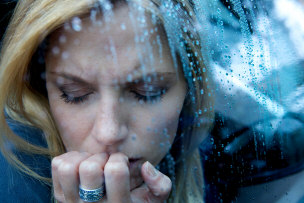 Seasonal affective disorder, also aptly referred by the acronym SAD, is a
depression that generally sets in during the wintertime. Because the days are
shorter as well as gloomier, SAD is believed to be the result of a lack of
sunlight. SAD, as most kinds of depression, affects more women than men and
happens--not surprisingly--the most often in the Northern Hemisphere. Seasonal affective disorder, also aptly referred by the acronym SAD, is a
depression that generally sets in during the wintertime. Because the days are
shorter as well as gloomier, SAD is believed to be the result of a lack of
sunlight. SAD, as most kinds of depression, affects more women than men and
happens--not surprisingly--the most often in the Northern Hemisphere.
SAD Symptoms:
The depressive condition is noted by the following symptomatology:
- Lethargy, or decreased energy
- Problems with concentrating
- Tiredness or fatigue
- Increased appetite and weight gain
- Oversleeping
SAD Can Occur in the Summer Too
Some people, although less frequently, suffer from SAD in the summer months
too. When the seasonal depression sets in during the summer months, it generally
has the opposite effect of its wintertime counterpart. Therefore, if people
experience SAD in the summer, they'll be more prone to lose weight than gain it
and will often find it hard to sleep. SAD, whether it occurs in the winter or
summer, is attributed to hormonal changes in the brain.
Light Therapy is Used to Treat Winter Seasonal Affective Disorder
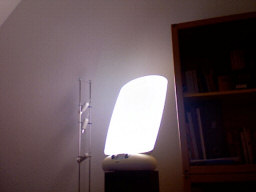 However, that being said, the light therapy used to treat SAD is directed
toward treating winter depression. The minority of people who suffer from
depression in the summer usually reside in warmer climates. Therefore, their
depressive episodes are attributed to the additional heat and humidity rather
than a lack of light. While winter lends to feelings of tiredness and apathy,
SAD in the summer can lead to irritation and even violence. However, that being said, the light therapy used to treat SAD is directed
toward treating winter depression. The minority of people who suffer from
depression in the summer usually reside in warmer climates. Therefore, their
depressive episodes are attributed to the additional heat and humidity rather
than a lack of light. While winter lends to feelings of tiredness and apathy,
SAD in the summer can lead to irritation and even violence.
Two Neurotransmitters Can Affect One's Seasonal Moods
Two neurotransmitters in the brain (serotonin and melatonin) are responsible
for affecting one's energy level and mood.
Serotonin
Antidepressants are typically used to increase levels of serotonin, a
neurotransmitter that increases one's feelings of contentment. When natural
light is increased, the serotonin increases too, all which is conducive to a
good mood.
A lack of sunlight results in a reduction in the production of serotonin, all
which leads to depression.
When the production of serotonin is reduced then, depression sets in along
with tiredness, cravings for excess carbs, and a resulting weight gain. Foods
that are high in carbs, such as pretzels or chips, increase serotonin levels,
thereby satisfying one's cravings in this regard. While some people experience
only mild symptoms of the winter blues, others may almost become debilitated
from the condition.
Melatonin
Melatonin, on the other hand, is produced more abundantly when light levels
are low - an aid to helping one slow down and sleep. During the wintertime then,
the level of melatonin in the body increases, which causes your energy to wane
and depression to take hold.
A Change of Seasons Can Mean A Change in One's Thinking Too
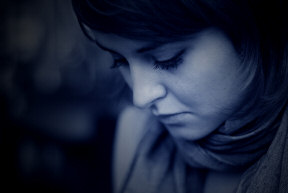 Indeed, seasonal variations can affect one's thinking and attitudes. Winter
symptoms usually start in the month of November and taper off by early spring.
In some cases, patients who experience winter depression will start to feel low
as early as late summer while others may not experience any real symptoms until
the beginning of January. Regardless of when the depression sets in, most
patients won't start to feel entirely better until the first part of May. Indeed, seasonal variations can affect one's thinking and attitudes. Winter
symptoms usually start in the month of November and taper off by early spring.
In some cases, patients who experience winter depression will start to feel low
as early as late summer while others may not experience any real symptoms until
the beginning of January. Regardless of when the depression sets in, most
patients won't start to feel entirely better until the first part of May.
While not everyone exhibits all the symptoms associated with recurrent
depression, they will still suffer from one or more of the classic signs,
including oversleeping, overeating, daytime tiredness, or weight gain. In
addition, other depressive behaviors may overtake the sufferer, including
apathy, hopelessness, and even thoughts of suicide.
Light Therapy - A Positive Treatment for SAD or Winter Depression
|
A Typical Light Box for SAD Treatment:
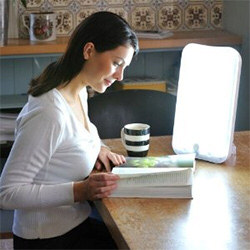
|
Fortunately, many sufferers of the winter blues find that they feel better
when they undergo light therapy. Light therapy is a good alternative if you
don't want to take antidepressants and your depression is mild to moderate.
Patients are exposed to a device called a light box - a piece of equipment that
simulates sunlight.
Side Effects that Can Result from Light Therapy:
Mental health professionals advise patients to spend about 30 minutes each
morning in front of the therapy lamp. While some side effects may result, they
can be eliminated by reducing the light's intensity. Common adverse reactions
may include headache, fatigue, nausea, or eyestrain.
Treating SAD with Antidepressants
However, those reactions can be controlled or eliminated, unlike some of the
side effects that result from taking antidepressants. Seasonal affective
disorder can also be treated with medications that increase serotonin levels in
the brain. The most popular medicines used in this regard are Paxil, Prozac, and
Zoloft.
Paxil
Paxil (also known as paroxetine) is an antidepressant that is classified
under the drug listing of selective serotonin reuptake inhibitors (SSRIs). The
drug is used to treat SAD, anxiety, obsessive-compulsive disorder, premenstrual
dysphoric disorder (PMDD,and post-traumatic stress disorder (PTSD).
Side effects
from taking Paxil may include:
- Headache
- Insomnia
- Restlessness
- Dizziness
- Drowsiness
- Nausea
- Digestive disturbances
- Ringing in the ears
Prozac
Generically referred to as fluoxetine, Prozac, like Paxil, is classified
under the drug grouping of selective serotonin reuptake inhibitators (SSRIs).
Prozac works to alleviate depression, and symptoms related to
obsesslive-compulsive disorder, anxiety, or panic attacks. The drug is also used
to treat premenstrual dysphoric disorder (PMDD).
Side effects from taking Prozac may include:
- Drowsiness
- Feelings of nervousness, tremors, or sweating
- Indigestion
- Nausea
- Insomnia
- Strange Dreams
- Rash
- Weight changes
- Sinus pain
- Cold-like symptoms
Zoloft
Another selective serotonin reuptake inhibitor (SSRI), Zoloft (generically
known as sertraline) is used to treat obsessive-compulsive disorder, depression,
premenstrual dysphoric disorder (PMDD), post-traumatic stress disorder (PTSD),
and anxiety.
Side effects from Zoloft can include:
- Drowsiness
- Dizziness
- Fatigue
- Nausea
- Stomach pain and upset
- Changes in weight
- Insomnia
Making a Treatment Decision
Given that the side effects from light therapy can be controlled, many people
suffering from the winter blues prefer light therapy over antidepressants.
However, since most SAD sufferers are women between 15 and 55, some of the
recommended medications can be used to treat SAD as well as female-related
ailments. That's why it's important to discuss all the options with your doctor
when choosing a course of therapy.
A Successful Treatment for Winter Depression
If you want to keep any side effects to a minimum though, light therapy has
been proven to work. Because winter depression is associated more with the
generation of light rather than with the temperature, light therapy is a
practical treatment. If the symptoms of winter depression are not interfering
with your daily activities, you can easily incorporate SAD light treatments into
your routine. Reportedly, 65% of the users have benefited from light therapy.
Using a Light Box
 Therefore, when you do purchase a light box, buy a larger lamp to obtain the
maximum benefits. Doctors generally recommend that patients use the light in the
early hours of the day. Doing so in the evening can cause sleeplessness. Keep
the eyes open during the treatment sessions. You don't have to stare at the
light - just look at it naturally. Therefore, when you do purchase a light box, buy a larger lamp to obtain the
maximum benefits. Doctors generally recommend that patients use the light in the
early hours of the day. Doing so in the evening can cause sleeplessness. Keep
the eyes open during the treatment sessions. You don't have to stare at the
light - just look at it naturally.
Making a Diagnosis
A SAD diagnosis is made for individuals who have undergone more than one
winter of depression. Therefore, for the diagnosis to be accurate, you should
have had symptoms for the last two successive years. Also, the episodes of
winter depression should outnumber the episodes of depression that are
non-seasonal.
Cognitive Behavioral Therapy
Cognitive behavioral therapy (CBT) may also be used in combination with light
therapy for the treatment of SAD. Cognitive behavioral therapy is a type of
psychotherapy that helps a patient reassess his thinking so he can handle
situations more effectively. CBT is a proven treatment for both depression and
anxiety and can greatly assist in helping people get rid of incorrect patterns
of thought.
Light Therapy Benefits - Why Light is Often Chosen over Taking
Antidepressants
Light therapy features four major advantages:
- It can take antidepressants as long as six weeks to two months to start
working - a long time to wait, especially when you're fighting depression in
the wintertime. Light therapy, on the other hand, generally takes a week or
two to work. In some cases, people feel better almost immediately.
- Light therapy, as already noted, has fewer side effects - reactions that
can be controlled with the intensity of the light you use or simply
eliminated by altering the position or timing for your light.
- Although artificial light is produced, light therapy is still a more
natural way to fight depression. Light therapy addresses the actual cause
for winter depression (a lack of light) while antidepressants treat the
symptoms that result from a lack of sunlight.
- Because sunlight is known to regulate your circadian rhythms (or your
internal clock), the light that you receive from a light box enables you to
sleep better and feel more energized.
Light Therapies
Two light therapies are used in treating the winter blues. One of the
treatments involves the use of a full spectrum light. This kind of light
replicates the white light of the sun. The other kind of light therapy, known as
blue light therapy, is directed toward the light and dark receptors in the eyes.
Duplicating the color of a blue summer sky, the light can help cure you of jet
lag as well.
A Common Type of Light
The common device used regularly for bright light therapy is a light box
containing a fluorescent lamp. The light conveys from 2,500 to 10,000 lux of
light for a distance of one to two feet. If you want to prevent headaches or
eyestrain, try to find a device that uses a balanced spectrum light. Look at the
light box for 30 minutes if your lamp is set at 10,000 lux or twice that long if
the light is set at 5,000 lux. Sit at a distance of just over a foot from the
light.
A Light Therapy Visor
If you want to integrate your light therapy with your daily activities, you
might consider purchasing a light visor, which can be worn on the head. Patients
wear the visor while walking, doing chores around the house, or preparing meals.
An Example of a Visor (Video):
Dawn/Dusk Simulator Lighting
To supplement bright light therapy, you may also think about using a
dawn/dusk simulator, used with a timing device and a light therapy bedside lamp.
If you have trouble waking up, the simulator can help in this regard.
The Sleeping and Waking Cycle - Times to Use the Light
Time Your Therapy in the Morning if You are Sleepier in the Early AM
The sleeping and waking cycle is an integral part of light therapy as
sufferers of the winter blues show two distinct sleep phases. Phase delayed
patients, which make up the majority of SAD sufferers, generally have more
trouble waking up in the morning and typically feel sluggish for a couple hours
thereafter.
Photo therapy for these individuals then is recommended for the early
morning. For those people in this group who tend to become tired later in the
day, a second 5-minute session at 10,000 lux may be beneficial. A light
treatment scheduled around 3:00 to 5:00 in the afternoon can enhance one's
quality of sleep.
Early Risers Should Time Their Therapy for Later in the Day
A small percentage of SAD sufferers, or phase advanced patients, generally
are early birds. They're alert in the morning hours, up to around noon. Because
they tend to retire earlier in the day, a 30-minute light session of 10,000 lux
is beneficial when practiced from 4:00 to 7:00 p.m.
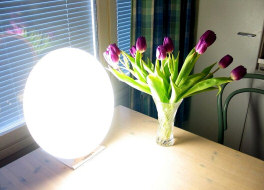 Stay on a Regular Treatment Course Stay on a Regular Treatment Course
By regularly adhering to light therapy at the same time daily, you'll slowly
start to note a gradual decrease in symptoms. After the symptoms abate, you can
pare down the time for each session in half. Once you feel better, you can even
skip a day without a setback. Begin the light sessions before your symptoms
begin to become pronounced in the wintertime.
Avoid Getting Too Much Light
The above-recommended amounts of light should suffice as too much light isn't
good either. Side effects, such as agitation or irritability, may occur if you
extend your light session beyond what is recommended for the amount of light you
should use.
A Few Tips on Making a Selection
When you do finally select a light, make sure your therapy lamp is meant to
treat SAD. Therapy lamps are also available on the market that are specifically
designed to cure sleeping disorders and even skin conditions such as acne. A
sunlamp should emit a full spectrum light or, at the minimum, 2,500 lux. Again,
if you can, pay a little more for the lamp, and choose a higher intensity light,
or one that emits 10,000 lux.
Lamps Generally Need Replacement after a Couple Years
Whatever light you choose, make sure it is well-ranked in the reviews. Lights
can be set up in the corner of a room, on a desk, or placed on a table. Plan on
replacing the lamp after two to three years.
Diseases & Conditions
Top Lists:
Top 10 Most Common Genetic Disorders
Top 15 Most Disturbing Skin Conditions
10 Unusual Phobias
Informational:
Diverticular Disease and Diverticulitis
What is Turner Syndrome and Why Does it Affect Only Females?
Alice in Wonderland Syndrome and How to Treat the Symptoms
Herniated Disc: Symptoms and Treatments
Pinch Nerve: The Cause of Remote Pain
Dealing With a Child Who Has a Fever
How Unhealthy Diet Could Trigger Inflammatory Arthritis
Phobias: Understanding How They Develop and Treatments
Depression Facts, Symptoms & Treatment
Earaches - Causes and Treatments
Symptoms of Borderline Personality Disorder and How to Deal with It
Seasonal Affective Disorder: Does Light Therapy Help?
What Really Causes Dandruff and How Can You Treat the Symptoms
Treating Plantar Fasciitis or Heel and Arch Pain
Symptoms and Treatments of Aplastic Anemia
Using Sclerotherapy to Get Rid of Varicose Veins
Are the Side Effects of HGH Supplements Worth It?
ADD/ADHD Symptoms and Treatment
What are the Options for Hair Loss Treatments
Options for Frontal Hair Loss Treatment |